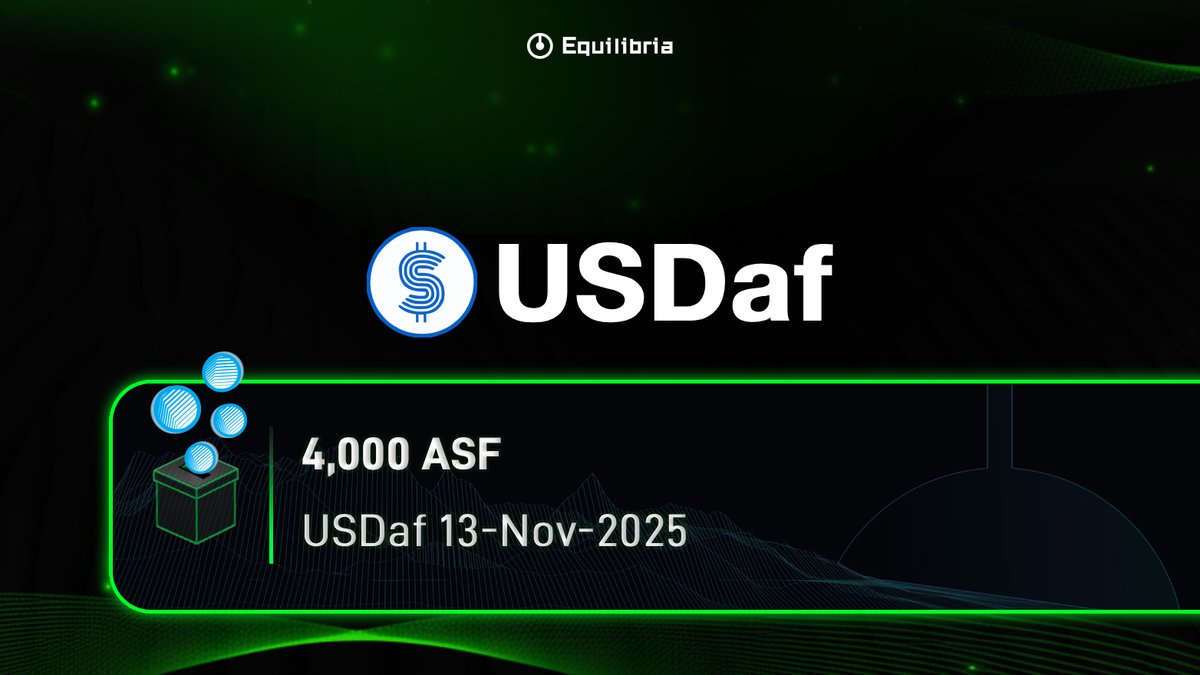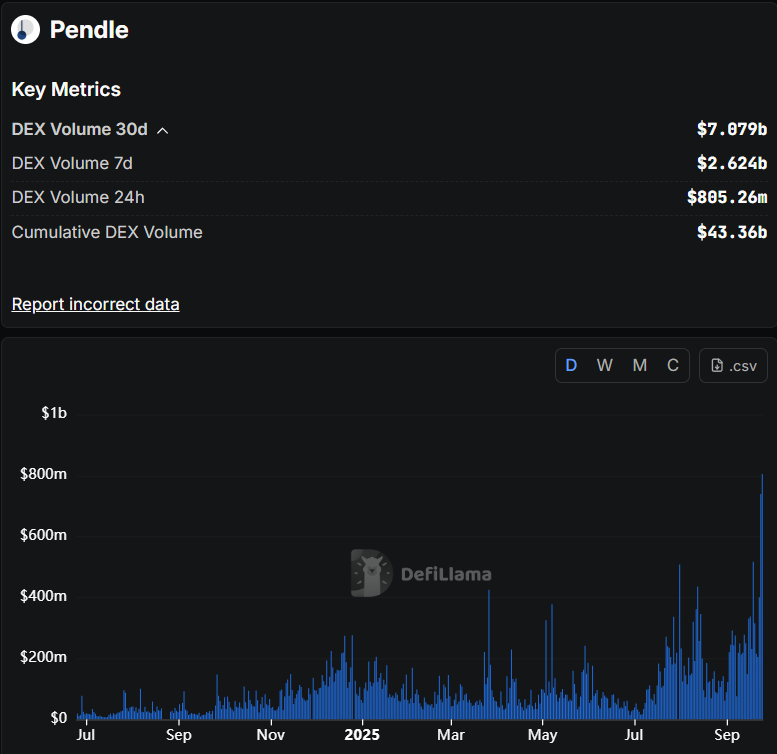Pendle price
in USD$4.748
-$0.135 (-2.77%)
USD
We can’t find that one.
Check your spelling or try another.
Check your spelling or try another.
Market cap
$802.93M #58
Circulating supply
169.14M / 281.53M
All-time high
$7.142
24h volume
$79.18M
3.7 / 5


About Pendle
PENDLE is a revolutionary cryptocurrency that enables users to unlock and trade future yield from various assets in decentralized finance (DeFi). By utilizing Pendle’s unique yield tokenization system, investors can split assets into Principal Tokens (PTs) for fixed yield and Yield Tokens (YTs) for variable yield, providing unparalleled flexibility and composability. PENDLE supports diverse use cases, including passive income strategies, yield farming, and risk management, making it a cornerstone for stablecoin, liquid staking, and funding rate derivatives. Trusted by top DeFi protocols and integrated across leading ecosystems, PENDLE empowers users to maximize capital efficiency while participating in the growing decentralized yield market.
AI-generated
Pendle’s price performance
Past year
--
--
3 months
+42.66%
$3.33
30 days
-12.45%
$5.42
7 days
-3.87%
$4.94
Pendle in the news
Almanak launched its alUSD stablecoin on Pendle today, offering a 1.25x multiplier on Almanak Points...
Ethena, Pendle, and Aave form a powerful DeFi yield engine. This article explores how they work together and how Hyperliquid could expand this system.
Pendle on socials

Final hours, but the incentives are still glowing on Equilibria’s voting market.✨
@asymmetryfin has lined up ~$2,350 worth of 4,000 ASF for USDaf — giving vlEQB holders the chance to lock in a solid share of next week’s $PENDLE emissions.
Cast your vote now, secure the boost, and let USDaf roll into the next epoch stronger.➡️

Guides
Find out how to buy Pendle
Getting started with crypto can feel overwhelming, but learning where and how to buy crypto is simpler than you might think.
Predict Pendle’s prices
How much will Pendle be worth over the next few years? Check out the community's thoughts and make your predictions.
View Pendle’s price history
Track your Pendle’s price history to monitor your holdings’ performance over time. You can easily view the open and close values, highs, lows, and trading volume using the table below.

Pendle on OKX Learn
Pendle Wallet: Unlocking the Future of Yield Tokenization in DeFi
What is Pendle Wallet? Pendle Wallet is an integral part of the Pendle Finance ecosystem, a cutting-edge decentralized finance (DeFi) protocol that specializes in tokenizing and trading future yield.
How Pendle's Expansion into TradFi and DeFi Proposals is Reshaping Financial Markets
Introduction: Bridging DeFi and TradFi The financial industry is undergoing a transformative evolution as decentralized finance (DeFi) protocols like Pendle bridge the gap between traditional finance
PEPE, AAVE, and PENDLE: Top Insights on Meme Coins, Whale Activity, and DeFi Innovations
Introduction to PEPE, AAVE, and PENDLE The cryptocurrency market continues to evolve, with tokens like PEPE , AAVE , and PENDLE capturing significant attention due to their unique characteristics and
Pendle TVL Market: Key Milestones, Innovations, and Growth Projections You Need to Know
Introduction to the Pendle TVL Market The decentralized finance (DeFi) ecosystem has experienced explosive growth, and Pendle Finance is emerging as a transformative force in the fixed-income sector.
Pendle FAQ
Currently, one Pendle is worth $4.748. For answers and insight into Pendle's price action, you're in the right place. Explore the latest Pendle charts and trade responsibly with OKX.
Cryptocurrencies, such as Pendle, are digital assets that operate on a public ledger called blockchains. Learn more about coins and tokens offered on OKX and their different attributes, which includes live prices and real-time charts.
Thanks to the 2008 financial crisis, interest in decentralized finance boomed. Bitcoin offered a novel solution by being a secure digital asset on a decentralized network. Since then, many other tokens such as Pendle have been created as well.
Check out our Pendle price prediction page to forecast future prices and determine your price targets.
Dive deeper into Pendle
Pendle is a yield-trading protocol that allows users to earn fixed or flexible yields.
ESG Disclosure
ESG (Environmental, Social, and Governance) regulations for crypto assets aim to address their environmental impact (e.g., energy-intensive mining), promote transparency, and ensure ethical governance practices to align the crypto industry with broader sustainability and societal goals. These regulations encourage compliance with standards that mitigate risks and foster trust in digital assets.
Disclaimer
The social content on this page ("Content"), including but not limited to tweets and statistics provided by LunarCrush, is sourced from third parties and provided "as is" for informational purposes only. OKX does not guarantee the quality or accuracy of the Content, and the Content does not represent the views of OKX. It is not intended to provide (i) investment advice or recommendation; (ii) an offer or solicitation to buy, sell or hold digital assets; or (iii) financial, accounting, legal or tax advice. Digital assets, including stablecoins and NFTs, involve a high degree of risk, can fluctuate greatly. The price and performance of the digital assets are not guaranteed and may change without notice.
OKX does not provide investment or asset recommendations. You should carefully consider whether trading or holding digital assets is suitable for you in light of your financial condition. Please consult your legal/tax/investment professional for questions about your specific circumstances. For further details, please refer to our Terms of Use and Risk Warning. By using the third-party website ("TPW"), you accept that any use of the TPW will be subject to and governed by the terms of the TPW. Unless expressly stated in writing, OKX and its affiliates (“OKX”) are not in any way associated with the owner or operator of the TPW. You agree that OKX is not responsible or liable for any loss, damage and any other consequences arising from your use of the TPW. Please be aware that using a TPW may result in a loss or diminution of your assets. Product may not be available in all jurisdictions.
OKX does not provide investment or asset recommendations. You should carefully consider whether trading or holding digital assets is suitable for you in light of your financial condition. Please consult your legal/tax/investment professional for questions about your specific circumstances. For further details, please refer to our Terms of Use and Risk Warning. By using the third-party website ("TPW"), you accept that any use of the TPW will be subject to and governed by the terms of the TPW. Unless expressly stated in writing, OKX and its affiliates (“OKX”) are not in any way associated with the owner or operator of the TPW. You agree that OKX is not responsible or liable for any loss, damage and any other consequences arising from your use of the TPW. Please be aware that using a TPW may result in a loss or diminution of your assets. Product may not be available in all jurisdictions.
Market cap
$802.93M #58
Circulating supply
169.14M / 281.53M
All-time high
$7.142
24h volume
$79.18M
3.7 / 5







